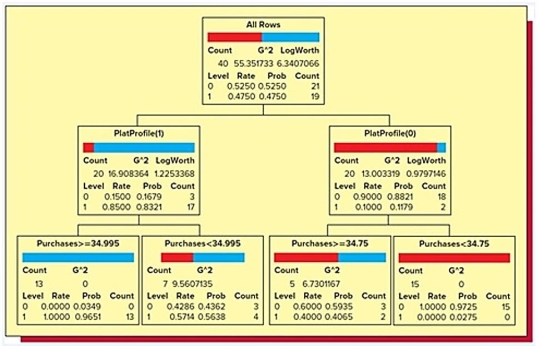Multiple Choice
Suppose that a bank wishes to predict whether or not an existing holder of its Silver credit card will upgrade, for an annual fee, to its Platinum credit card. To do this, the bank carries out a pilot study that randomly selects 40 of its existing Silver card holders and offers each Silver card holder an upgrade to its Platinum card. Here, the response variable Upgrade equals 1 if the Silver card holder decided to upgrade and 0 otherwise. Moreover, the predictor variable Purchases is last year's purchases (in thousands of dollars) by the Silver card holder, and the predictor variable PlatProfile equals 1 if the Silver card holder conforms to the bank's Platinum profile and 0 otherwise. Below is the classification tree they derived from the data collected in the study.  Of these 40 Silver card holders, what is the proportion that did not upgrade?
Of these 40 Silver card holders, what is the proportion that did not upgrade?
A) .5535
B) .5250
C) .4750
D) .1179
E) .1000
Correct Answer:

Verified
Correct Answer:
Verified
Q63: An internet service provider (ISP) has randomly
Q64: An MBA admissions officer wishes to predict
Q65: An internet service provider (ISP) has randomly
Q66: Which of the following possible response variables
Q67: Because different trust levels may be appropriate
Q69: A cable television company has randomly selected
Q70: An internet service provider (ISP) has randomly
Q71: An automobile finance company analyzed a sample
Q72: An automobile finance company analyzed a sample
Q73: An internet service provider (ISP) has randomly